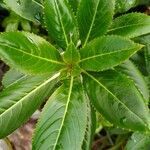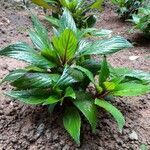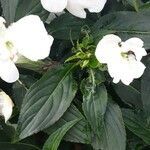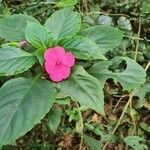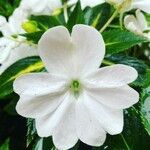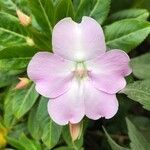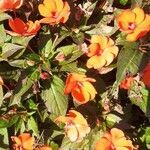Herb, erect, usually branched, rather succulent; stems terete, thick, glabrous, usually striate, usually translucent, minutely white spotted. Leaves alternate, spirally arranged, often crowded above, the blade broadly elliptic or ovate, usually translucent, glabrous, 2.5-10 cm long, 1.3-5 cm broad, acute to short-acuminate at the apex, marginally crenate-denticulate with tentacular hairs on the apex of the crenations, narrowly cuneate at base, often forming a narrow wing on the petiole, with 7-12 pairs of ascending, inconspicuous, lateral veins; petiole 1-3 cm long, usually glabrous, with 1-several marginal tentacular hairs, the hairs to 1 mm long, flattened at the apex. Inflorescences of few-flowered racemes; peduncles 4-5 cm long, glabrous. Flowers usually dark, carmine, red, pink, orange, or violet, with the pedicel 2-2.2 cm long, glabrous, with a pair of linear-lanceolate bracts at the base of the pedicel, the bracts to 3 mm long, glabrous; lateral sepals 4-7 mm long, 2-3 mm broad, ovate-lanceolate, acute, usually glabrous, green; posterior sepal to 1.5 cm long, shallowly navicular, abruptly constricted into the spur, the spur up to 4 cm long, slender, slightly curved, glabrous; anterior petal to 12 mm long, up to 18 mm broad, broadly ovate or obcordate, usually retuse to emarginate at the apex; lateral petals united, very deeply 2-lobed, the lobes equal in size and shape, 1.5-2 cm long, 1.2-1.4 cm broad, obovate, rounded or subtruncate at apex; ovary usually glabrous. Capsule to 18 mm long, fusiform, glabrous; seeds numerous, ca 1.5 mm in diam, pyriform, blackish, usually covered with short thick hairs.
Plants perennial, succulent, green or reddish tinged, 30-70 cm tall, simple or branched, glabrous or rarely slightly pubescent at shoot apices. Leaves alternate; petiole 1.5-6 cm, with 1 or 2, rarely few, stipitate glands; leaf blade broadly elliptic or ovate to oblong-elliptic, 4-12 × 2.5-5.5 cm, with 1 or 2, rarely few, stipitate basal glands, glabrous, lateral veins 5-8 pairs, base cuneate, rarely ± rounded, attenuate into petiole, margin crenate-denticulate, apex acute or acuminate, or somewhat cuspidate. Inflorescences in leaf axils of upper stem and branches, usually 2(-5)-flowered, sometimes 1-flowered; peduncles 3-5 cm. Pedicels 1.5-3 cm, slender, bracteate at base; bracts linear-lanceolate or subulate, ca. 2 mm, apex acute. Flowers variable in size and color: red, crimson-red, pink, purple-red, purplish violet, or white. Lateral sepals 2, greenish or whitish, ovate-lanceolate or linear-lanceolate, 3-7 mm, apex acute. Lower sepal shallowly navicular, 0.8-1.5 cm deep, abruptly constricted into a curved spur; spur filiform, 2.4-4 cm. Upper petal broadly obcordate or obovate, 1.5-1.9 × 1.3-2.5 cm, apex emarginate, cuspidate, abaxial midvein narrowly cristate; lateral united petals not clawed, 1.8-2.5 cm, 2-lobed; basal and distal lobes nearly equal in size and shape; basal lobes obovate or obovate-spatulate, 1.4-2 × ca. 1.4 cm; distal lobes 1.2-2.3 × ca. 1.8 cm, margin entire or emarginate. Ovary fusiform, ca. 4 mm, glabrous. Capsule fusiform, 1.5-2 cm, glabrous. Fl. Jun-Oct. 2n = 16.
Herb, perennial, to 1 m high (usually less than 0.5 m high); stems ±succulent, rooting at the lower nodes, glabrous or rarely slightly pubescent at shoot apices. Leaves alternate; lamina ovate to broadly ovate, 3–11 cm long, 10–50 mm wide, sometimes reddish below, glabrous, with 5–8 pairs of lateral veins, margin coarsely toothed, apex acuminate; petiole 10–40 mm long, not or scarcely winged, with scattered, thick-stalked glands. Inflorescences axillary, usually 2 or 3 (–5)-flowered; peduncles 2–5 cm long. Pedicels 10–30 mm long, slender, bracteate; bracts linear-lanceolate or subulate, acute, c. 2 mm long. Flowers mostly pink to red or orange, sometimes white, with face ±flat; spur white, 3–4.5 cm long. Sepals: lowermost sepal 8–15 mm long, whitish, with spur 20–35 mm long; lateral sepals 3–7 mm long, green. Petals 10–20 mm long; uppermost petal largest, keeled; lateral petals fused towards base. Capsule glabrous, fusiform, weakly 5-ribbed, swollen in the middle, 15–20 mm long, c. 3 mm wide. Seeds tuberculate.
Leaves spirally arranged, very rarely apparently opposite, petiolate; lamina very variable in shape and size, (3) 4·5–10 (15) × (2) 2·5–5 (7·5) cm., broadly elliptic or ovate to elliptic-oblong or ovate-oblong, subsucculent, usually translucent, dark or pale green to reddish-green on both surfaces, glabrous on both surfaces or rarely scattered-pilose beneath (mainly on the nerves), apex acute, often acuminate or cuspidate, rarely obtuse, margin crenate-denticulate, often with tentacular hairs on the apex of the crenations towards the base, base usually narrowly (but sometimes broadly) cuneate or rarely rounded and usually with the lamina running down the petiole and thus forming a narrow wing; secondary nerves 7–12 pairs, not very prominent beneath; petiole (1) 2–4·5 (6·5) cm. long, succulent, usually glabrous.
Anterior petal up to 12 mm. long, up to 18 mm. broad (when flattened), very broadly ovate or obcordate, with the apex usually retuse to emarginate, rarely acute, dorsally very narrowly cristate; lateral united petals very deeply 2-lobed (the lobes appearing nearly separate), with the lobes nearly equal in shape and size, 10–20 × 7–15 mm. (sometimes even larger), obliquely obovate, obovate-spathulate or obovate-cuneate, with the apex rounded or sub-truncate (see t. 26 fig. 25).
Lateral sepals (3) 4–7 × 2·25–3 mm. (in cultivated specimen sometimes slightly larger), ovate-lanceolate or lanceolate-triangular, acute, glabrous (always?), green; posterior sepal relatively small, up to 1·5 cm. long, c. 0·5 cm. deep, shallowly navicular, bluntish-keeled, abruptly constricted into the spur, distally sometimes subcaudate, usually acute or subobtuse; spur up to 4 cm. long, slender, slightly curved, usually with the end somewhat thickened, glabrous.
Flowers in few-flowered axillary and/or terminal racemes, rarely apparently 1-flowered by reduction (but then the “pedicel” always with a small bract about the middle), very variable in colour and size, dark carmine, wine-red, pink, orange, violet, rarely white; bracts up to 6 mm. long, lanceolate-triangular, acute; pedicel 1–2·5 (3) cm. long, slender, succulent, usually glabrous.
Juicy perennial herb, 30–50 (80) cm. high, usually branched to form a flat top; stems erect or straggling, succulent, thick, glabrous or rarely scattered-pilose, usually translucent, green or reddish, sometimes rooting at lower nodes.
Succulent, perennial herb, up to 0.8 m high. Leaf lamina glabrous; petiole with a few stipitate glands scattered along its length; lateral veins 5-8 pairs. Flowers pinkish mauve.
A herb. It grows 15-60 cm tall. The leaves are broad and sword shaped. They are 3-12 cm long by 2-5 cm wide. The flowers are 2-5 cm across. The seed pods explodes when ripe.
Seeds numerous, c. 1·75 × 1·5 mm., pyriform, rusty or blackish, ± densely covered with short thick hairs on papillose bases.
Capsule up to 18 mm. long, broadly oblique-fusiform, glabrous.
Ovary usually glabrous.
